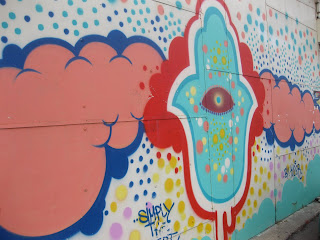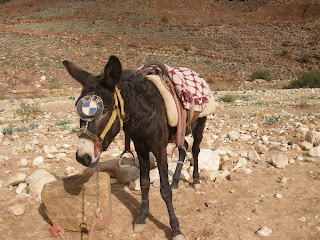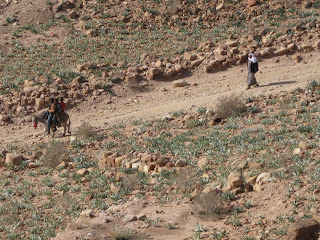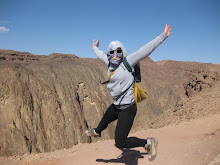In a fashion true to myself, here is my first blog post, over two months after my arrival in Israel.
Ok, so. Here's where I am: Kibbutz Yechiam, Western Galilee, Israel http://en.wikipedia.org/wiki/Yehiam
I'm going to address my Birthright tour adventures first, for sake of chronology. As told through picture and word:
It's important to know that I did not sleep the night before my flight out to Israel. Instead, I stayed up making my niece's first birthday party dress. (Pictures coming soon!) I figured I would sleep on the plane, and while I slept in the car to the airport (Sorry, Larry and Gina), I only got about 2 hours of broken up sleep during the flight. We landed in Tel Aviv around 7:30 and were promptly hustled onto our tour bus. (Hustling is a theme of the trip.) We started out driving north to Haifa, where we stopped to look at the Baha'i Garden. We said the Shehechianu and drank some grape juice and were back on the bus in less than 20 minutes. Yalla! (C'mon!)

Next was a "nature walk - sandals acceptable". At first we thought maybe we misinterpreted what our tour guide, Irad, meant by "nature walk", but by the end of the trip we understood that first day really was, quite literally, a walk in the park. Nevertheless, this happened afterward:

We got to the Kibbutz we were staying at, ate dinner (some of the best hummus I've ever had), and went to sleep. By the time I got into bed I had been awake roughly 60 hours without sleeping.
In the morning we went down into the Chula Valley to a Bird Sanctuary. We saw a bunch of cranes, and by a bunch I mean hundreds. Yalla to the next part of our day which was a walking tour of Tsfat. There we joined up with the Israeli soldiers that traveled with us for five days. Tsfat is really pretty and old. All the doors are painted cobalt blue in an effort to keep bugs out of the homes. There is an artist colony in Tsfat and we went to hear an artist named Abraham (aka Robert from Detroit) talk about Kabbalah. His lecture was short because He had to pick up his kids from... soccer? But, He did manage to say "awesome" what felt like over 100 times in twenty minutes, which I think is awesome.
A tour of Galil Mountain Winery was next. We also got to do some wine tasting. It was a neat coincidence to be there because last Passover my Dad and I went on a long search for good kosher wine and came back with a bottle of Galil Mountain wine. Usually kosher wine is pasteurized and that's what make it taste... not so good. Kosher wine has to be pasteurized because otherwise, according to Kashrut laws the wine can only be handled by devout Jewish men to ensure that it is kosher. Galil Mountain Wine is good is because they don't pasteurize and opt instead for all their employees who directly handle the wine to be religious Jews.
The next day we went on a hike

through a valley

to a waterfall!

After the hike we went up to a decommissioned bunker on the border with Lebanon. There I found out Gilligan got off the island and joined the IDF:

Trenches above the bunker.

I couldn't read the sign about it since it was in Hebrew, but there were lots of sculptures made from what looked like old weapon parts. I'm a sucker a flower in a gun barrel.

We kept up our hustled pace and, after some lunch in an Israeli strip mall, we drove down to the Kineret to swim in a hot spring. It was the kind that's really a pool with hot spring water channeled in. I'd rather have hiked to a natural hot spring, but it was pretty funny to see how pissed all the old people were when 40 American 20-somethings rolled up. We only had about an hour there and then we bussed it down to Jerusalem, where we stayed for the next three nights. On the way, Jay led us in a sing-a-long, and we discovered that we all know the lyrics to Lean on Me and but not to Semi-Charmed life.

We got to the hotel in the center of Jerusalem and had to run in to eat dinner before even bringing our bags to our rooms since we were running late (again). The rooms were pretty nice if not cramped and absent of right angles.
Our first day in Jerusalem was a walking tour of the Old City. The pictures on Google image search are much nicer than mine from that day, so I'll just share some of the 'art' shots I took in the market.



Alex, you have a creeper doppelganger in Israel:

Nim, I found your pants:


That night was Erev Shabbat (Sabbath Eve) and we went to the Kotel. By the time we arrived, there were already hundreds of people gathered. As I got closer to the Wall on the women's side (the sexes must be separated during prayer, according to orthodox tradition), the crowd filled in so that it was hard to move without bumping anyone. I don't like being in big crowds, so I was surprised to feel comforted in the throng. There were many circles of women dancing and singing together. It reminded me of Miriam leading the Israelite women in celebration after crossing the Red Sea out of Egypt. I joined a circle of women from Britain and though I didn't know their melodies to the prayers, they helped me follow along. I felt joyful as I made my way backwards through the crowd, so as not to turn my back on the most holy Jewish place in the world.
Afterward, we went out to a bar where I ordered a liter of beer, which is something you can do here in Israel.
On Saturday we walked to the park by the Kinesset and the Israelis taught us some dangerous games that kindergartners play here. (That's foreshadowing.) Here's a picture of Nimrod explaining the rules to balloon pop. Behind him is Sapir, Maayan, Yarden, Balloon-head Shaked and Gal.

Jay and Max(?) dunked their faces into bowls of flour in pursuit of taffy. Jay won!

Adam beat Dan at egg-on-spoon-in-mouth race...

and Alexandria broke her wrist.

This is me jumping in front of the Kinesset.

This is a picture of the best meal I've had since I've been in Israel. Fried halumi cheese with avocado, grilled veggies and salad greens on the best whole wheat bread ever baked.

On our last day in Jerusalem we went to Yad Vashem, the Holocaust museum, and Mount Herzel, the Israeli national military cemetery. I'm having a hard time finding the words to explain what that day was like. Studying the Holocaust and going to Holocaust museums is always emotionally trying, but this time was different somehow. I think being in the museum with only other Jews, even the ones who don't identify as Jewish, made the experience more profound. the museum is laid out so that you are forced to follow a zig-zagging path around pictures, maps and former belongings while the space around you becomes diminished and cramped. The effect is that it sometimes forces one into extreme closeness with the others around them and at other times isolates the visitor into seclusion. The result of which, for me, was an overwhelming feeling of oppressive, constrictive sadness, alternating with bouts of helpless isolation. The museum path opens out onto a balcony with an amazing view of the hillsides of Jerusalem. I felt immense relief as I walked out of the dark hallway into the warm sun. As everyone silently gathered in the courtyard, we held each other and cried.
Then we walked into the woods next to Yad Vashem and ate lunch. Pizza, we found out, tastes good when we cry.

When lunch was finished we walked over to Mount Herzel. We visited the grave site of Theodore Herzel, Father of Zionism, and headed into the cemetery. Irad took us to some notable graves, including Golda Meir, the first female Prime Minister of Israel and one of my childhood role models. We also learned about a few Israeli heroes who died in action, including Michael Levin, a lone soldier from Philadelphia, who was killed in action during the Second Lebanon War. (A lone soldier is a Jew from another country, with no family here in Israel, who volunteers in the IDF.) http://lonesoldiercenter.com
The idea of a hero is very important for an army and the nation behind it. I think one of the reasons for the support and success of the IDF, is not just that the men and women serving and all Israeli civilians have heroes to look up to, but also that these heroes are ordinary people. Every Israeli citizen must serve in the army and therefore has the potential to become a national hero. What makes a lone soldier special is that they volunteer to put themselves in harms way. They are the embodiment of the idea that Israel is the home of all Jews, not just Israeli's, and that idea is worth fighting for.

After our tour of Mount Herzel we sat in a big circle and each said a few words about our experiences with the soldiers who had spent the past five days with us. Before it was my turn to speak, I realized that my patriotic American belt buckle had broken. It may have been caused by the mood of the day, but the instant I realized that the buckle, with a bald eagle holding two soaring American flags, was broken, I took it as a sign that I should make Aliyah. I don't usually make impulsive decisions, especially big ones like changing allegiance, but that night I did promise myself I would consider it. (Aliyah is when a Jew in diaspora moves back to Israel. I'll devote a post to this after my visit to the MASA Aliyah informational session next Tuesday.)
Here are all the soldiers with the Birthright staff. It was a beautiful and emotional farewell.


We left Jerusalem for the Dead Sea and managed to get in some beach time before waking up at 4AM for our Masada hike. I learned how to skip a stone on water!

Sunrise on our way to Masada; that's it to the right.

There it is again, with me jumping in front.

Water break.

Arin at sunrise.

Grant at sunrise.

Our hike took us around the base of Masada, up the neighboring plateau, up to the roman ramp to a whole lotta stairs and then...

Josh read us an account of what was said the night before the Romans invaded, written by the man who betrayed the Jews hiding there to the Romans, who was in Jerusalem at the time. Or something. It was very dramatic.

We didn't stay on Masada for too long, considering we needed to get back to the hotel to eat breakfast by 9. In an effort to balance our desert hike, after breakfast we went on a stream hike to an oasis with a waterfall. It was beautiful and fun to play in the water!





From the oasis we went straight to the Dead Sea for some mud and salt action. You have to pay for mud there, which makes about the same amount of sense as paying for water. Also, the mud looked like poop.

See?
I put some hand prints on Aaron's back to make it look like he'd been macked on. I think I did a good job.

Jump shot fail. Someone else has a better shot of this.


Yalla! Time for another activity. We headed south to a farm in the desert to see Israeli agriculture in action. This farm is GM free but does a lot of cross pollination and other neat biological tricks to make tomatoes taste like salmon and other such things. They let us eat the veggies off of the plants. I tried some of the tomatoes and peppers. Some were good and others reinforced my initial reaction which is that tomatoes shouldn't taste like fish.

They also grow and export flowers, mostly to Europe.

Next day, in the Negev. Our hike took us through a dry river bed, it was mostly down hill. The highlight was the section of the trail on the border with Egypt. It was pretty dusty so I wrapped up like a ninja and took some sweet jump shots in front of the border with Egypt. The ravine marks the border.




I imagine this is what it looked like when the Israelites were wandering in the desert for 40 years, minus the Camelbacks and hiking boots, plus the manna and matzah.

When we finished the hike, we went back to Eilat to go for a dip in the Red Sea. Eilat really reminds me of the Jersey Shore, but different. These pictures show how:


Yalla! Camel riding was next. My camels name was Sahara, and she really liked Aaron's camel. I was really nervous at first, but then I was able to relax. Thats when the camels spooked a little bit and we had a mini stampede that was majorly scary.

That night we camped out in the desert. I took some pictures that I think are pretty cool. Jay led us in what, I think, was the best sing-a-long of the trip, which culminated in an improvised song about Irad's manhood and our group being sexually nerdy.

Oh, and I taught everyone what I learned in college:











Next Day, Sunrise.

Early morning in the desert is cold. We cuddled.

The last hike of the trip was to the summit of Mt. Shlomo. The mountains in the far background are in Jordan.



The mountains of the Negev were formed at two different times, which is why some of the mountains are dark (granite) and others are light (sandstone).

Liza and me scrambling up the mountain. Believe it or not that wasn't even the peak.

Rebecca and Kristina at the summit!

It took us two hours to hike to the summit and four hours to descend. After hour four I got a little bored but there were plenty of dry waterfalls to navigate that kept my attention. Fear of falling 20-30 feet tends to help. When we finally got to the bus I was ready to sleep for hours, which worked out great because the next thing we did was drive 5 hours to Tel Aviv.
We got to the hotel and, once again, were late for dinner. So we ended up with only an hour to eat, shower and get ready for our "night-out-on-the-town!". Yalla! We did it though, and went out to a club at the Tel Aviv port (which doesn't function as a port anymore, but does have a really cool wavy boardwalk). It was a pretty awesome last night.
The last day of our trip was spent in Tel Aviv. (I feel bad for everyone that went home right after the trip and only spent one day there, because Tel Aviv is the most fun place to be in Israel.) First was a visit to Independence Hall. Then we walked around Rabin Square and visited the Memorial there. It is the most unique and morbid memorial I have ever seen.
The memorial is comprised of a dry fountain in front of the spot where Yitzchak Rabin was assassinated, markers on the sidewalk showing exactly where Rabin, his bodyguards, other officials and finally the murderer were standing and a nearby wall of graffiti created in the night following the assassination by the mostly young crowd that stayed until morning. The most notable of all the graffiti is the word 'סליחה' which means 'sorry'. The memorial is completed by a brass plaque with a bas-relief recreation of a photograph taken at the moment of the assassination. Everyone in the picture is named, save for the assassin who is simply remembered as "Murderer".
There are important attributes about Israeli culture to be learned in regards to the assassination of Rabin. First of all, the Israeli people not only make no attempt to shirk from the reality of their felled compatriots, but exalt them, (I will address this further in my future post about Yom Hazikaron) as exemplified by the markers at the memorial. Second, is the effort that goes into diminishing the identity, and therefore humanity, of the perpetrators of acts of terror or war. Despite this, and this leads me to my third observation, is that Israel seems holds human life in such high regard that there is no death penalty; (with the exception of the most heinous of crimes including, but not limited to, genocide and crimes against humanity) Rabin's murderer remains in jail on a life sentence with no option for parole.
After the square we lightened the mood with a visit the the Shook HaCarmel. We ate lunch there and walked through Nefetzedek to Jaffa. Nefetzedek was the first section of Tel Aviv, settled 101 years ago and is a preserved historical site. It is Illegal to change the facade of any of the buildings in order to maintain the unique look of the neighborhood. Jaffa is the old city of Tel Aviv and is where most of the Israeli Arabs live and, from what I could tell, where some hip kids and artists live too. Both neighborhoods are beautiful and were made even more so by the reflected light of the overcast day.









We finished our trip with dinner at an outdoor restaurant that luckily had tents to protect us from what was now a stormy night. We ate shakshuka (fried eggs over tomato sauce) pita and lots of other yummy stuff. Then we drove back to the airport where I said a bittersweet l'hitraot! (see you later!) to my new friends who were returning to the states. Then a bunch of us made our way back to Tel Aviv...
 Almost a month after getting to Yechiam, we started volunteering. Oranim encourages its participants to volunteer in the local high school tutoring students in English. I was looking forward to working out in the fields, but this proved not to be an option due to my gender. So, I compromised and ended up volunteering in the kindergarten on the kibbutz.
Almost a month after getting to Yechiam, we started volunteering. Oranim encourages its participants to volunteer in the local high school tutoring students in English. I was looking forward to working out in the fields, but this proved not to be an option due to my gender. So, I compromised and ended up volunteering in the kindergarten on the kibbutz. I really like the idea of re-using old items instead of throwing them away and I think this is a much simpler and effective way to use recycled products than how its done in the U.S. but I have to draw the line at a "giraffe" made from rusted metal frame work.
I really like the idea of re-using old items instead of throwing them away and I think this is a much simpler and effective way to use recycled products than how its done in the U.S. but I have to draw the line at a "giraffe" made from rusted metal frame work.






























































































































